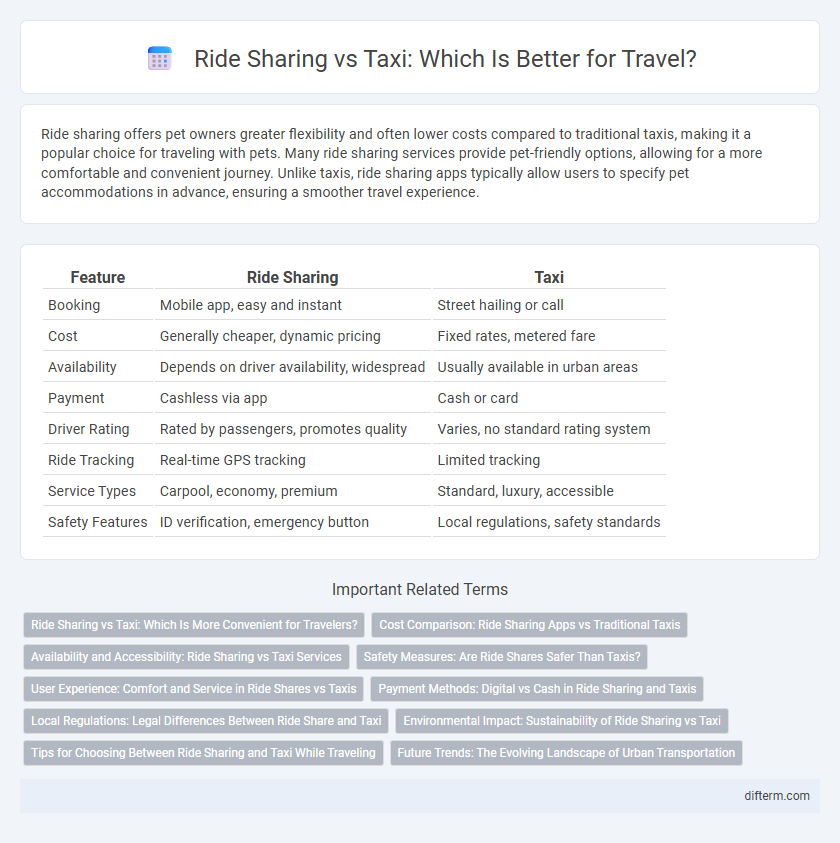Ride sharing offers pet owners greater flexibility and often lower costs compared to traditional taxis, making it a popular choice for traveling with pets. Many ride sharing services provide pet-friendly options, allowing for a more comfortable and convenient journey. Unlike taxis, ride sharing apps typically allow users to specify pet accommodations in advance, ensuring a smoother travel experience.
Table of Comparison
| Feature | Ride Sharing | Taxi |
|---|---|---|
| Booking | Mobile app, easy and instant | Street hailing or call |
| Cost | Generally cheaper, dynamic pricing | Fixed rates, metered fare |
| Availability | Depends on driver availability, widespread | Usually available in urban areas |
| Payment | Cashless via app | Cash or card |
| Driver Rating | Rated by passengers, promotes quality | Varies, no standard rating system |
| Ride Tracking | Real-time GPS tracking | Limited tracking |
| Service Types | Carpool, economy, premium | Standard, luxury, accessible |
| Safety Features | ID verification, emergency button | Local regulations, safety standards |
Ride Sharing vs Taxi: Which Is More Convenient for Travelers?
Ride sharing offers travelers greater convenience with app-based booking, real-time driver tracking, and often lower fares compared to traditional taxis. Taxi services provide fixed rates and regulated safety standards, appealing to those who prioritize reliability and predictability during their trips. Travelers seeking efficiency and cost-effectiveness often prefer ride sharing, while those valuing formalized service may choose taxis for urban or airport transportation.
Cost Comparison: Ride Sharing Apps vs Traditional Taxis
Ride sharing apps typically offer lower base fares and dynamic pricing models that can reduce costs during off-peak hours compared to traditional taxis, which usually charge fixed rates and higher minimum fees. Surge pricing in ride sharing may increase expenses during high demand, but overall, app-based rides generally provide more affordable and transparent pricing options. Traditional taxis often incur extra charges such as meter surcharges and tip expectations, making ride sharing a more cost-effective choice for many travelers.
Availability and Accessibility: Ride Sharing vs Taxi Services
Ride sharing services offer greater availability through app-based platforms that connect riders with nearby drivers 24/7, often expanding accessibility to underserved areas and reducing wait times. Taxi services typically have fixed dispatch zones and operate from specific locations, which can limit their availability during off-peak hours or in remote regions. Both options provide unique accessibility benefits, but ride sharing's technology-driven approach often enhances convenience for urban and suburban travelers.
Safety Measures: Are Ride Shares Safer Than Taxis?
Ride shares implement advanced safety measures such as driver background checks, GPS tracking, and in-app emergency features that enhance passenger security. Taxis may lack consistent safety protocols, varying widely by city and company, which can affect overall passenger safety. Statistically, ride shares report lower incidents due to real-time monitoring and user feedback systems that enable rapid responses to safety concerns.
User Experience: Comfort and Service in Ride Shares vs Taxis
Ride sharing services often provide personalized comfort through app-based vehicle selection, real-time driver ratings, and cashless payments, enhancing convenience and user satisfaction. Taxis generally offer immediate street hails and regulated fares, but may lack the customizable comfort options found in ride shares. Both modes prioritize safety and comfort, yet ride shares deliver a seamless digital experience tailored to individual preferences.
Payment Methods: Digital vs Cash in Ride Sharing and Taxis
Ride sharing platforms predominantly offer digital payment options, including credit cards, mobile wallets, and in-app payment systems, ensuring convenience and contactless transactions. Taxis traditionally rely on cash payments, though many have adapted to accept cards and mobile payments to stay competitive. The shift towards digital payments in ride sharing enhances transparency, improves ride tracking, and reduces the risk associated with cash handling for both drivers and passengers.
Local Regulations: Legal Differences Between Ride Share and Taxi
Local regulations distinguish ride-sharing services from taxis through licensing requirements, fare controls, and vehicle standards, with taxis often subject to stricter oversight and fixed pricing schemes established by municipal authorities. Ride-sharing platforms operate under different legal frameworks, usually involving background checks and digital permits rather than traditional taxi medallions, enabling greater flexibility but varying compliance across regions. Enforcement policies impact driver eligibility, insurance mandates, and service availability, shaping the competitive landscape between both transportation options.
Environmental Impact: Sustainability of Ride Sharing vs Taxi
Ride sharing significantly reduces carbon emissions by maximizing vehicle occupancy and decreasing the number of cars on the road compared to traditional taxis, which often operate with lower passenger density. Electric and hybrid vehicles are increasingly incorporated into ride sharing fleets, enhancing sustainability efforts beyond conventional taxi services. Data from urban mobility studies reveal that ride sharing can lower per-passenger emissions by up to 30%, contributing to cleaner city air and reduced traffic congestion.
Tips for Choosing Between Ride Sharing and Taxi While Traveling
When choosing between ride sharing and taxis while traveling, consider factors such as cost, convenience, and safety ratings of each option. Ride sharing apps often provide upfront pricing and user reviews, making budget management easier, while taxis may offer quicker street hails in busy urban areas. Evaluating availability, app reliability, and payment flexibility ensures a smoother transportation experience tailored to your travel destination and schedule.
Future Trends: The Evolving Landscape of Urban Transportation
Ride sharing services leverage real-time data analytics and AI to optimize routes, reduce wait times, and lower emissions, positioning them as a sustainable option in urban transportation's future landscape. Autonomous vehicles integration within ride sharing platforms promises to further reduce costs and improve safety, challenging traditional taxi models. Smart city infrastructure investments will accelerate seamless connectivity between ride sharing and public transit, reshaping urban mobility ecosystems toward efficiency and environmental sustainability.
ride sharing vs taxi Infographic

 difterm.com
difterm.com